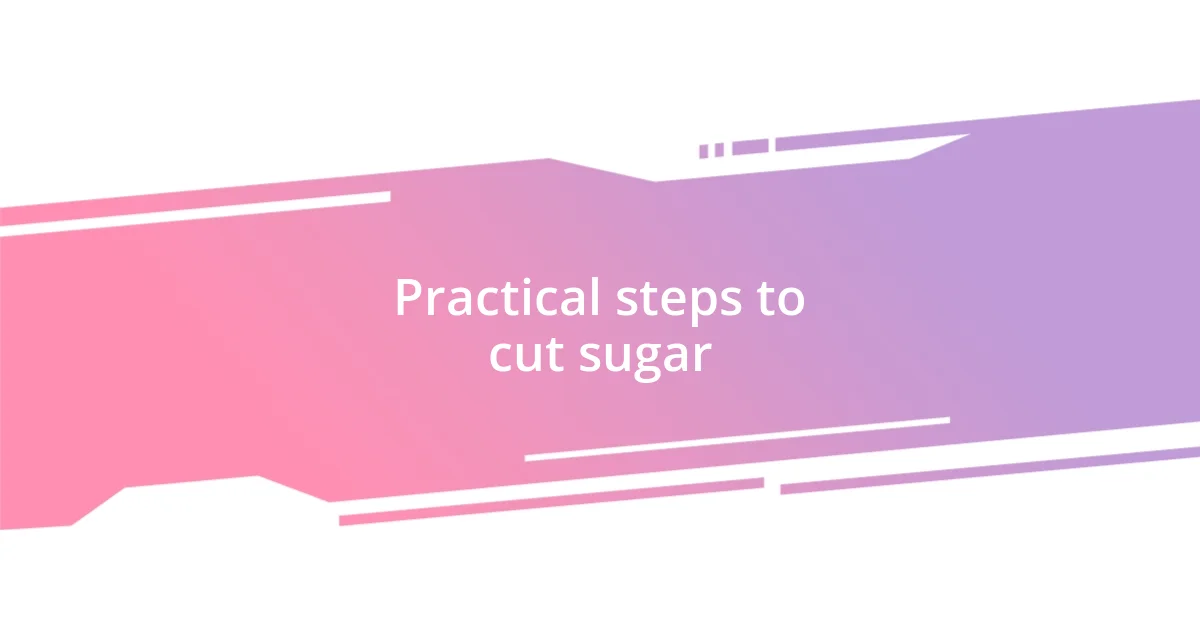Key takeaways:
- Understanding the effects of sugar consumption extends to both physical health and emotional well-being, influencing energy levels and mood stability.
- Identifying hidden sugars in everyday foods and being aware of misleading product labeling is crucial for reducing overall sugar intake.
- Tracking progress through journaling and celebrating small victories can enhance motivation and support a successful journey to cut back on sugar.

Understanding sugar consumption effects
Understanding the effects of sugar consumption goes beyond just looking at numbers on a nutrition label. I remember when I used to enjoy sugary snacks without giving it much thought. Over time, I noticed that my energy levels would spike right after indulging but then crash, leaving me feeling lethargic and foggy. Have you ever experienced that rollercoaster of energy?
It’s fascinating how sugar can alter not just our physical health, but also our mood and emotions. Whenever I’ve consumed too much sugar, I often find myself feeling irritable and anxious. This link between sugar and mood has made me reflect on what I really want to fuel my body with. Isn’t it interesting how something seemingly harmless like candy can affect our emotional state so dramatically?
Moreover, the long-term implications of excessive sugar intake can be quite alarming, from increased risk of obesity to diabetes. I’ve seen friends struggle with their weight after years of seemingly innocent sugary drinks. It makes you wonder, doesn’t it? How much of our daily habits genuinely contribute to our health in the long run? Recognizing these effects is a crucial step towards taking control of our health narratives.

Identifying hidden sugars in foods
Identifying hidden sugars in foods can be quite an eye-opener. I recall the time I discovered that my beloved barbecue sauce was loaded with sugar. One day, out of curiosity, I checked the label and was shocked to see “high fructose corn syrup” listed as one of the top ingredients. It made me realize that many condiments and sauces, which I thought were relatively healthy, could be sneaking in more sugar than I’d like to admit. Have you ever checked the ingredients in the items you use every day?
It’s essential to look beyond just the word “sugar” when scanning food labels. I’ve learned that terms like “sucrose,” “glucose,” and “dextrose” are all forms of sugar that can contribute to that sneaky overall intake. When I started paying attention to these synonyms, I found they appear in places I least expected—like bread and salad dressings! This practice not only helped me cut back on sugar but also enhanced my awareness of what I was actually eating.
Don’t forget to watch out for “natural” sugars in seemingly healthy products. I once bought a smoothie labeled as “100% fruit,” only to find it was packed with concentrated fruit juices that contain a hefty dose of sugar. It left me feeling puzzled—wasn’t it supposed to be healthy? It’s a reminder that marketing can be misleading, and being informed is crucial if you want to truly reduce your sugar intake.
| Common Ingredients | Hidden Sugar Types |
|---|---|
| High Fructose Corn Syrup | Sweetener derived from corn |
| Agave Nectar | Fructose-rich syrup |
| Maltodextrin | Processed carbohydrate |
| Brown Sugar | Refined sugar with molasses |
| Fruit Juices | Concentrated natural sweetness |

Practical steps to cut sugar
Implementing practical steps to cut sugar can be surprisingly straightforward once you commit to it. I vividly recall how daunting it felt when I first started. But by swapping out just a few items in my pantry, I made remarkable progress. For instance, I replaced my morning sugary cereal with oatmeal topped with fresh fruit. Such a small change made a world of difference in how I felt throughout the day.
- Keep hydrated with water or unsweetened beverages instead of sugary drinks.
- Gradually reduce added sugars in your coffee or tea until you enjoy it without sweeteners.
- Choosing whole fruits over fruit juices allows you to enjoy natural sweetness without the added sugars.
- Read labels and opt for unsweetened versions of your favorite snacks and yogurts.
- Explore spices like cinnamon or vanilla to add flavor without the sweetness.
When I made it a habit to prepare meals at home, I found that I could control what I consumed more effectively. I remember one night after cooking a delicious homemade stir-fry, I realized I didn’t miss the sugary sauces I used to pour on dishes. Instead, I felt proud of using fresh vegetables and herbs. It’s amazing how empowering it is to take charge of what goes into your body!
- Plan your meals to avoid impulse purchases that often lead to high-sugar snacks.
- Incorporate more whole foods—like vegetables, legumes, and whole grains—into your diet.
- Set specific goals, like having “sugar-free days” throughout the week.
- Practice mindful eating to help identify cravings and avoid emotional eating.
- Share your journey with friends or family for support and accountability.

Healthy alternatives to sugary snacks
When it comes to satisfying a sweet tooth without the guilt, I’ve found that whole fruits are my best friends. Not only do they offer natural sweetness, but the textures and flavors can be so diverse! Just think about biting into a juicy apple or a succulent berry. It feels like I’m indulging, but I know I’m giving my body something nutritious instead of a sugary snack that would leave me crashing soon after. Have you ever noticed how much better you feel after choosing fruit over candy?
Another great alternative I’ve enjoyed is creating my own energy bites. I mix dates, nuts, and a sprinkle of cocoa powder for a treat that not only curbs my cravings but also fuels my energy levels. It’s satisfying to make something from scratch that tastes great and is healthy, too! Plus, I love being able to customize the ingredients to suit my preferences—there’s no more guessing what’s in my snacks!
Lastly, I recommend swapping out traditional snack bars for healthier options like homemade granola bars or yogurt with nuts and seeds. I still remember the first time I made my own granola bars; the sweet aroma filled my kitchen, and I couldn’t wait to taste them. The proud moment when I bit into one—crunchy, sweet, and nourishing—was worth every second of preparation. How often do we get that kind of satisfaction from store-bought snacks? Embracing these healthier choices has changed the way I view snacking, making it an opportunity for nourishment rather than just a sugary fix.

Tracking progress and staying motivated
Tracking progress on my sugar reduction journey has been crucial for staying motivated. I found that keeping a journal helped me not only note what I ate but also how I felt afterward. When I looked back and saw how far I’d come, writing about my cravings, my victories, and even my slip-ups, it was like seeing a roadmap of my progress. Have you ever documented a change in your life? The reflection can be just as rewarding as the accomplishment!
In addition to journaling, I’ve embraced the power of apps that track my food intake. Initially, I was skeptical, but once I started using one, I discovered patterns in my eating habits that I hadn’t noticed before. For example, I realized I craved sugar more on stressful days. Knowing this helped me develop better coping strategies, like taking a walk instead of reaching for a cookie. Do you ever find that certain situations trigger cravings? Recognizing these triggers has been a game changer for my motivation.
Lastly, I discovered the importance of celebrating small victories along the way. Whether it’s treating myself to a nice dinner out after a week of sugar-free living or simply acknowledging that I chose fruit over candy at a friend’s gathering, these moments genuinely boost my enthusiasm. I still remember the pride I felt the first time I went a whole day with no added sugars. How often do we take a moment to appreciate our efforts? By injecting positivity into my journey, I motivated myself to keep pushing forward, and I hope you will, too!














